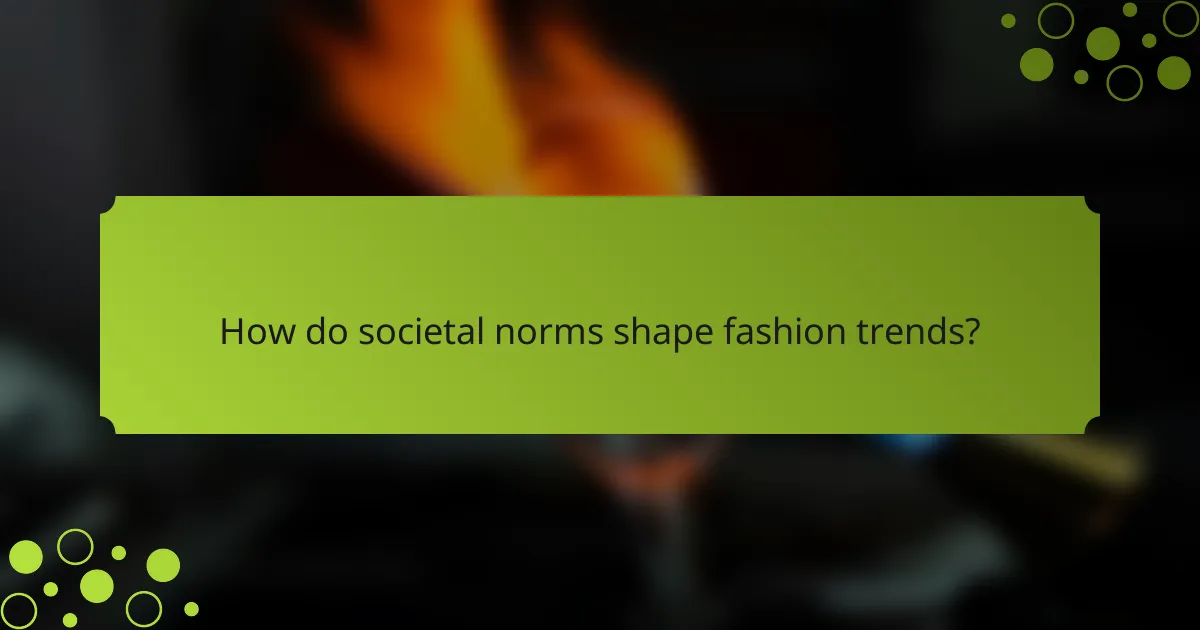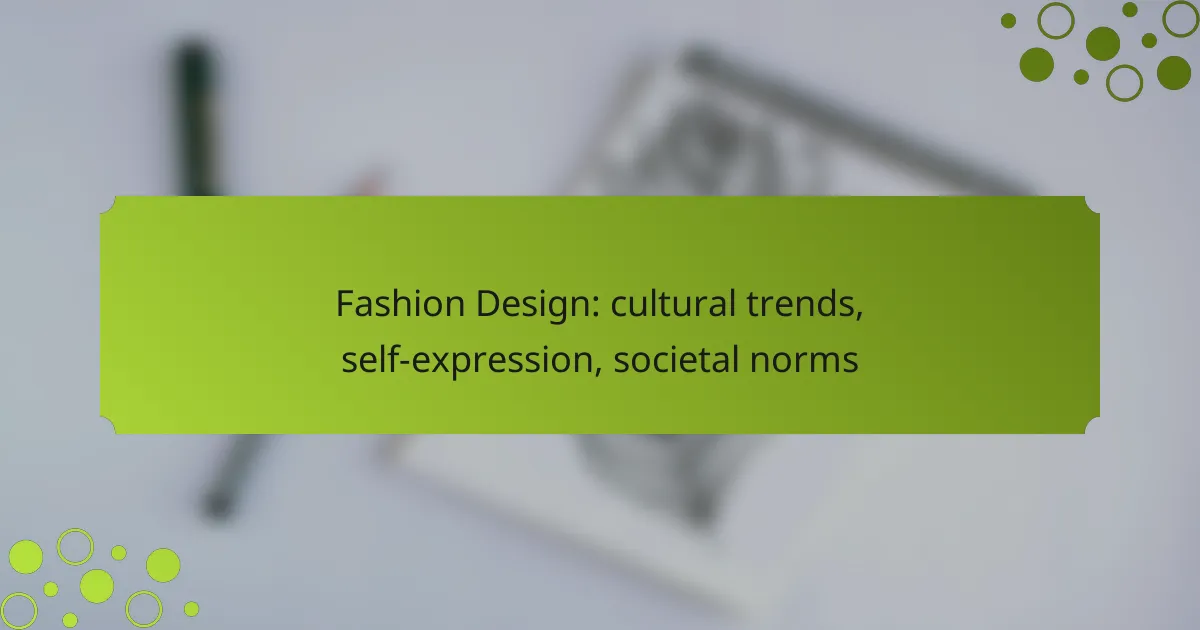Fashion design serves as a vibrant canvas for cultural trends, self-expression, and societal norms, particularly in diverse contexts like Australia. Designers weave together local customs and contemporary movements, creating styles that resonate with the unique identities of their communities. Through clothing, individuals articulate their beliefs and emotions, while societal norms shape perceptions of what is deemed acceptable in fashion. This dynamic interplay highlights the evolving nature of fashion as a reflection of cultural values and social change.

How do cultural trends influence fashion design in Australia?
Cultural trends significantly shape fashion design in Australia by reflecting the diverse identities and values of its population. Designers often draw inspiration from local customs, historical narratives, and contemporary societal movements, resulting in a unique blend of styles that resonate with Australian culture.
Indigenous Australian influences
Indigenous Australian influences play a crucial role in contemporary fashion design, showcasing traditional art and storytelling through clothing. Designers incorporate Indigenous motifs, colors, and techniques, often collaborating with Indigenous artists to ensure authenticity and respect for cultural heritage.
This integration not only elevates Indigenous narratives but also promotes awareness and appreciation among broader audiences. Fashion events and exhibitions increasingly feature Indigenous designs, highlighting their significance in the Australian fashion landscape.
Urban streetwear movements
Urban streetwear movements in Australia are characterized by a blend of casual styles and bold statements, often reflecting the youth culture and social issues. This trend emphasizes comfort and individuality, with elements like oversized silhouettes, graphic tees, and sneakers becoming staples.
Local streetwear brands frequently draw inspiration from Australian landscapes and urban environments, creating a distinct aesthetic. Collaborations between streetwear labels and artists or musicians further amplify this movement, making it a dynamic part of the fashion scene.
Global fashion collaborations
Global fashion collaborations have become increasingly prominent in Australia, allowing local designers to merge their unique perspectives with international trends. These partnerships often result in limited-edition collections that blend Australian aesthetics with global influences, appealing to a wider audience.
Such collaborations can enhance brand visibility and create opportunities for cross-cultural exchange. Australian designers participating in global fashion weeks or partnering with international retailers can leverage these connections to elevate their work on the world stage.

What role does self-expression play in fashion choices?
Self-expression is fundamental in fashion choices, allowing individuals to communicate their identity, beliefs, and emotions through their clothing. This personal articulation often reflects cultural trends and societal norms, shaping how people perceive themselves and others.
Personal branding through clothing
Clothing serves as a powerful tool for personal branding, enabling individuals to convey their values and professional identity. For instance, a creative professional might opt for vibrant colors and unique patterns, while someone in a corporate setting may choose more subdued tones and classic styles.
To effectively use clothing for personal branding, consider your target audience and the message you want to send. A consistent style that aligns with your personal or professional goals can enhance recognition and influence how others perceive you.
Gender fluidity in fashion
Gender fluidity in fashion allows individuals to express themselves beyond traditional gender norms, embracing styles that reflect their personal identity. This movement encourages the blending of masculine and feminine elements, resulting in a diverse array of clothing options.
When exploring gender fluidity, consider incorporating pieces that challenge conventional gendered styles, such as oversized silhouettes or androgynous cuts. This approach not only promotes inclusivity but also fosters creativity in personal expression.
Social media impact on style
Social media significantly influences fashion choices by providing a platform for trends to emerge and spread rapidly. Platforms like Instagram and TikTok allow users to showcase their unique styles, inspiring others and creating a sense of community around shared interests.
To leverage social media for style inspiration, follow influencers and brands that resonate with your aesthetic. Engage with content that reflects your values and interests, but be mindful of the pressure to conform to fleeting trends, which can detract from authentic self-expression.

How do societal norms shape fashion trends?
Societal norms significantly influence fashion trends by dictating what is considered acceptable or desirable in clothing and style. These norms evolve over time, reflecting cultural values, economic conditions, and social movements.
Workplace attire expectations
Workplace attire expectations vary widely across industries and cultures, often reflecting the organization’s values and the nature of the work. In corporate environments, formal dress codes may prevail, requiring suits and ties or professional dresses, while creative fields like tech or design may embrace casual attire.
Understanding these expectations is crucial for professionals. Dressing appropriately can enhance credibility and confidence, while failing to adhere to norms may lead to negative perceptions. It’s advisable to observe colleagues and align your wardrobe accordingly.
Fashion sustainability movements
Fashion sustainability movements have gained traction as societal awareness of environmental issues increases. Consumers are increasingly favoring brands that prioritize eco-friendly materials and ethical production practices, influencing trends toward sustainable fashion.
To participate in this movement, consider supporting brands that use organic fabrics, recycled materials, or fair trade practices. Additionally, opting for second-hand clothing can reduce waste and promote a circular economy.
Body positivity in fashion
Body positivity in fashion challenges traditional beauty standards, promoting inclusivity and acceptance of diverse body types. This movement encourages brands to offer a wider range of sizes and to feature models of various shapes and backgrounds in their marketing.
As a consumer, embrace brands that align with body positivity principles. Look for companies that celebrate diversity and provide options that cater to all body types, ensuring that everyone feels represented and valued in the fashion industry.

What are the key factors in selecting fashion design elements?
Key factors in selecting fashion design elements include material selection, color theory application, and understanding target audience demographics. Each of these elements plays a crucial role in creating designs that resonate with consumers and reflect current cultural trends.
Material selection
Material selection is fundamental in fashion design as it affects the garment’s look, feel, and functionality. Designers should consider the properties of fabrics, such as breathability, durability, and drape, to ensure they align with the intended use of the clothing.
For example, lightweight cotton is ideal for summer wear, while heavier wool works well for winter collections. Additionally, sustainability is increasingly important, with many designers opting for eco-friendly materials to appeal to environmentally conscious consumers.
Color theory application
Color theory application is essential in fashion design, influencing mood and consumer perception. Designers should understand color combinations, contrasts, and the psychological effects of colors to create appealing collections.
For instance, warm colors like red and orange can evoke energy and excitement, while cool colors such as blue and green often convey calmness. Utilizing seasonal color palettes can also enhance the relevance of designs, aligning them with current trends.
Target audience demographics
Understanding target audience demographics is critical for effective fashion design. Designers must analyze factors such as age, gender, income level, and lifestyle to create pieces that meet the needs and preferences of their intended market.
For example, a brand targeting young adults may focus on trendy, casual styles, while a luxury brand may emphasize timeless elegance and high-quality materials. Conducting market research can provide insights into consumer behavior, helping designers tailor their collections accordingly.

How does fashion design reflect cultural identity?
Fashion design serves as a powerful medium for expressing cultural identity, showcasing the values, traditions, and aesthetics of different communities. Through clothing, accessories, and styles, individuals communicate their heritage and personal narratives, often blending traditional elements with contemporary influences.
Regional styles in Australian fashion
Australian fashion is characterized by its diverse regional styles, influenced by the country’s unique geography and multicultural population. From the laid-back beachwear of coastal areas to the vibrant Aboriginal designs that celebrate Indigenous heritage, these styles reflect a blend of natural elements and cultural stories.
Key trends include the use of sustainable materials and local craftsmanship, which resonate with the growing demand for eco-friendly fashion. Designers often draw inspiration from Australia’s landscapes, incorporating earthy tones and organic shapes that mirror the environment.
Fashion as a form of protest
Fashion has long been utilized as a means of protest, allowing individuals to challenge societal norms and advocate for change. Through clothing choices, activists can make bold statements about issues such as gender equality, climate change, and racial justice.
For example, the use of specific colors, symbols, or slogans on apparel can create visual solidarity among movements. Wearing items that signify resistance or support for a cause can foster community and raise awareness, making fashion a potent tool for social commentary.

What emerging trends are shaping the future of fashion design?
Emerging trends in fashion design are increasingly influenced by sustainability, technology, and cultural diversity. Designers are integrating eco-friendly materials, digital innovation, and inclusive practices to reflect societal changes and consumer demands.
Sustainability in Fashion Design
Sustainability is a key trend reshaping fashion design, focusing on reducing environmental impact. Brands are adopting eco-friendly materials like organic cotton, recycled polyester, and biodegradable fabrics to create collections that appeal to environmentally conscious consumers.
Additionally, sustainable practices include ethical labor standards and transparent supply chains. Designers are encouraged to consider the entire lifecycle of their products, from production to disposal, to minimize waste and promote responsible consumption.
Technological Integration
Technology is transforming fashion design through innovations such as 3D printing, virtual reality, and artificial intelligence. These tools allow designers to create prototypes faster and more efficiently, reducing time-to-market and resource use.
Moreover, digital platforms enable personalized shopping experiences, where consumers can customize designs to suit their preferences. This shift not only enhances customer engagement but also encourages brands to be more adaptive and responsive to market trends.
Cultural Diversity and Inclusivity
Cultural diversity is becoming a central theme in fashion design, promoting inclusivity and representation. Designers are drawing inspiration from various cultures, leading to more diverse collections that resonate with a broader audience.
Inclusivity extends beyond aesthetics; it involves creating clothing that accommodates different body types, genders, and cultural backgrounds. Brands that prioritize diversity are likely to build stronger connections with consumers and foster a more equitable fashion industry.
